DTAG: A Methodology for Aggregating Digital Twins Using the WoTDT Ontology
Abstract
1. Introduction
2. State of the Art
3. WoTDT Ontology Development
3.1. WoTDT Requirements
3.2. WoTDT Implementation
3.2.1. Physical Entity Dimension
3.2.2. Digital Entity Dimension
3.2.3. Virtual Entity Dimension
3.2.4. DTw Data Dimension
3.2.5. DTw Services Dimension
3.2.6. DTw Connections Dimension
3.2.7. Aggregation Method Conceptualisation
3.3. WoTDT Evaluation
3.4. WoTDT Publication and Maintenance
4. DTw Aggregation Methodology
- DTws instantiation, where the DTws involved in aggregation are instantiated using WoTDT ontology.
- DTws dimension aggregation development, where the information contained in the different dimensions of DTw involved are aggregated.
- DTwA maintenance, where the DTwA obtained from the aggregation process is updated according to the functionalities that will be performed.

- DTw developer: a DTw developer is part of the DTw development team and possesses extensive knowledge regarding the DTws used in the aggregation process.
- Domain expert: a domain expert possesses expertise in the fields addressed by the DTws used in the aggregation process.
- DTwA user: a DTwA user is the end user of the DTwA obtained from the aggregation process. This actor will also include DTw developers who will use and extend the DTwA knowledge and functions.
4.1. DTws Instantiation
4.1.1. DTw Metadata Extraction by Dimension
- DTw: DTw where the metadata are extracted.
- –
- DTw Identifier: identifier that represents the DTw.
- –
- DTw Title: title that describes the DTw specifically.
- Entity: entity or asset that is represented by the DTw.
- –
- Entity Identifier: identifier of the entity or asset represented by the DTw.
- –
- Entity Title: title that specifically describes the entity or asset that is represented by the DTw.
- Models: models used by the DTw to model its data.
- –
- Model Type: type of model described as subclasses in the model class of WoTDT ontology.
- –
- Model Identifier: identifier of the model.
- –
- Model Title: title that describes specifically the model.
- –
- Model Description (optional): description that describes the model.
- –
- Model Formats: formats in which the model can be found.
- –
- Model Access URL: URL where the model can be accessed.
- Resources: data resources used by the DTw.
- –
- Resource Type: type of data resource described as subclasses in the resource class of the reused DCAT ontology in the WoTDT ontology.
- –
- Resource Identifier: identifier of the resource.
- –
- Resource Title: title that describes specifically the resource.
- –
- Resource Description (optional): description that describes the resource.
- –
- Resource Access URL: URL where the resource can be accessed.
- –
- Resource Download URL (optional): URL where the resource can be retrieved.
- –
- Related Resources Identifier (optional): relations with other data resources, such as distributions or data services where a dataset is stored.
- Services: services used by the DTw to execute processes.
- –
- Service Type: if it is a property, action, or event affordance from the thing description ontology.
- –
- Service Identifier: identifier of the service.
- –
- Service Title: title that describes the service specifically.
- –
- Service Description (optional): description that describes the service.
- –
- Service Access URL: URL where the service can be accessed.
- –
- Service Content Type (optional): content type that returns the service, such as “application/json”.
- Connections: existing connections between the different dimensions of the DTw.
- –
- Connection Type: type of connection described as subclasses in the connection class of WoTDT ontology.
- –
- Connection Identifier: identifier of the connection.
- –
- Connection Title: title that describes specifically the connection.
- –
- Connection Description (optional): description that describes the connection.
- –
- Connection Provider Identifier: identifier of the connection provider.
- –
- Connection Consumer Identifier: identifier of the connection consumer.
4.1.2. Metadata Instantiation Using WoTDT Ontology
4.2. DTws Dimension Aggregation Development
DTwA Entity Creation
4.3. Digital Entity Aggregation
4.3.1. Models Aggregation
Non-Semantic Model Referenciation
Semantic Model Aggregation and Referenciation
- Ontology Aggregation
- Mappings Aggregation
- Shapes Aggregation (SHACL Shapes)
4.3.2. Resource Aggregation
Non-Semantic Data Resource Referenciation
Semantic Resource Aggregation
Interaction Affordance (Service) Referenciation
4.4. Connections Creation
4.5. DTwA Maintenance
5. Conclusions
Author Contributions
Funding
Institutional Review Board Statement
Informed Consent Statement
Data Availability Statement
Acknowledgments
Conflicts of Interest
Abbreviations
| AML | AgreementMakeLight |
| COGITO | Construction Phase Digital Twin Model |
| DCAT | Data Catalog Vocabulary Ontology |
| DTw | Digital Twin |
| DTwA | Digital Twin Aggregate |
| DTDL | Digital Twin Definition Language |
| DTwI | Digital Twin Instance |
| DTMI | Digital Twin Model Identifier |
| IoT | Internet of Things |
| IRI | Internationalised Resource Identifier |
| JSON | JavaScript Object Notation |
| KG | Knowledge Graph |
| LD | Linked Data |
| LOT | Linked Open Terms |
| NASA | National Aeronautics and Space Administration |
| OAEI | Ontology Alignment Evaluation Initiative |
| OWL | Web Ontology Language |
| PLM | Product Lifecycle Management |
| RDF | Resource Description Format |
| RDFs | RDF Schema |
| SHACL | Shapes Constraint Language |
| SPARQL | SPARQL and RDF Query Language |
| TD | Thing Description |
| URI | Uniform Resource Identifier |
| URL | Uniform Resource Locator |
| XSD | XML Schema Definition |
| W3C | World Wide Web Consortium |
| WoT | Web of Things |
| WoTDT | WoT Digital Twin Ontology |
| WoT TD | WoT Thing Descriptions |
References
- Hu, W.; Zhang, T.; Deng, X.; Liu, Z.; Tan, J. Digital twin: A state-of-the-art review of its enabling technologies, applications and challenges. J. Intell. Manuf. Spec. Equip. 2021, 2, 1–34. [Google Scholar] [CrossRef]
- D’Amico, R.D.; Erkoyuncu, J.A.; Addepalli, S.; Penver, S. Cognitive digital twin: An approach to improve the maintenance management. Cirp J. Manuf. Sci. Technol. 2022, 38, 613–630. [Google Scholar] [CrossRef]
- Grieves, M.; Vickers, J. Digital twin: Mitigating unpredictable, undesirable emergent behavior in complex systems. In Transdisciplinary Perspectives on Complex Systems: New Findings and Approaches; Springer: Berlin/Heidelberg, Germany, 2017; pp. 85–113. [Google Scholar] [CrossRef]
- Zheng, X.; Lu, J.; Kiritsis, D. The emergence of cognitive digital twin: Vision, challenges and opportunities. Int. J. Prod. Res. 2022, 60, 7610–7632. [Google Scholar] [CrossRef]
- Psarommatis, F. A generic methodology and a digital twin for zero defect manufacturing (ZDM) performance mapping towards design for ZDM. J. Manuf. Syst. 2021, 59, 507–521. [Google Scholar] [CrossRef]
- Cho, S.; May, G.; Kiritsis, D. A semantic-driven approach for industry 4.0. In Proceedings of the 2019 15th International Conference on Distributed Computing in Sensor Systems (DCOSS), Santorini, Greece, 29–31 May 2019; pp. 347–354. [Google Scholar]
- Grieves, M.W. PLM–beyond lean manufacturing. Manuf. Eng. 2003, 130, 23. [Google Scholar]
- Tao, F.; Zhang, M. Digital twin shop-floor: A new shop-floor paradigm towards smart manufacturing. IEEE Access 2017, 5, 20418–20427. [Google Scholar] [CrossRef]
- Kaebisch, S.; McCool, M.; Korkan, E. Web of Things (WoT) Thing Description 1.1. 2023. Available online: https://www.w3.org/TR/wot-thing-description11/ (accessed on 18 May 2024).
- Poveda-Villalón, M.; Fernández-Izquierdo, A.; Fernández-López, M.; García-Castro, R. Lot: An industrial oriented ontology engineering framework. Eng. Appl. Artif. Intell. 2022, 111, 104755. [Google Scholar] [CrossRef]
- Främling, K.; Holmström, J.; Ala-Risku, T.; Kärkkäinen, M. Product agents for handling information about physical objects. Rep. Lab. Inf. Process. Sci. Ser. B Tko-B 2003, 153, 20. [Google Scholar]
- Tuegel, E. The airframe digital twin: Some challenges to realization. In Proceedings of the 53rd AIAA/ASME/ASCE/AHS/ASC Structures, Structural Dynamics and Materials Conference, Honolulu, HI, USA, 23–26 April 2012. [Google Scholar]
- Ríos, J.; Hernández, J.C.; Oliva, M.; Mas, F. Product Avatar as Digital Counterpart of a Physical Individual Product: Literature Review and Implications in an Aircraft. Transdiscipl. Lifecycle Anal. Syst. 2015, 2, 657–666. [Google Scholar]
- Qi, Q.; Tao, F.; Zuo, Y.; Zhao, D. Digital twin service towards smart manufacturing. Procedia CIRP 2018, 72, 237–242. [Google Scholar] [CrossRef]
- Borangiu, T.; Oltean, E.; Răileanu, S.; Anton, F.; Anton, S.; Iacob, I. Embedded digital twin for ARTI-type control of semi-continuous production processes. In Service Oriented, Holonic and Multi-Agent Manufacturing Systems for Industry of the Future, Proceedings of the SOHOMA 2019 9, Valencia, Spain, 3–4 October 2019; Springer: Berlin/Heidelberg, Germany, 2020; pp. 113–133. [Google Scholar]
- Karanjkar, N.; Joglekar, A.; Mohanty, S.; Prabhu, V.; Raghunath, D.; Sundaresan, R. Digital twin for energy optimization in an SMT-PCB assembly line. In Proceedings of the 2018 IEEE International Conference on Internet of Things and Intelligence System (IOTAIS), Bali, Indonesia, 1–3 November 2018; pp. 85–89. [Google Scholar]
- Pan, Z.; Shi, J.; Jiang, L. A novel hdf-based data compression and integration approach to support bim-gis practical applications. Adv. Civ. Eng. 2020, 2020, 1–22. [Google Scholar] [CrossRef]
- Lutze, R. Digital twins in eHealth–: Prospects and challenges focussing on information management. In Proceedings of the 2019 IEEE International Conference on Engineering, Technology and Innovation (ICE/ITMC), Valbonne Sophia-Antipolis, France, 17–19 June 2019; pp. 1–9. [Google Scholar]
- Villalonga, A.; Negri, E.; Fumagalli, L.; Macchi, M.; Castaño, F.; Haber, R. Local decision making based on distributed digital twin framework. IFAC-Pap. 2020, 53, 10568–10573. [Google Scholar] [CrossRef]
- Ciavotta, M.; Alge, M.; Menato, S.; Rovere, D.; Pedrazzoli, P. A microservice-based middleware for the digital factory. Procedia Manuf. 2017, 11, 931–938. [Google Scholar] [CrossRef]
- Redelinghuys, A.; Kruger, K.; Basson, A. A six-layer architecture for digital twins with aggregation. In Service Oriented, Holonic and Multi-Agent Manufacturing Systems for Industry of the Future, Proceedings of the SOHOMA 2019 9, Valencia, Spain, 3–4 October 2019; Springer: Berlin/Heidelberg, Germany, 2020; pp. 171–182. [Google Scholar]
- Boje, C.; Guerriero, A.; Kubicki, S.; Rezgui, Y. Towards a semantic Construction Digital Twin: Directions for future research. Autom. Constr. 2020, 114, 103179. [Google Scholar] [CrossRef]
- Mayer, S.; Hodges, J.; Yu, D.; Kritzler, M.; Michahelles, F. An open semantic framework for the industrial Internet of Things. IEEE Intell. Syst. 2017, 32, 96–101. [Google Scholar] [CrossRef]
- Steinmetz, C.; Rettberg, A.; Ribeiro, F.G.C.; Schroeder, G.; Pereira, C.E. Internet of things ontology for digital twin in cyber physical systems. In Proceedings of the 2018 VIII Brazilian Symposium on Computing Systems Engineering (SBESC), Salvador, Brazil, 5–8 November 2018. [Google Scholar]
- Bermúdez-Edo, M.; Elsaleh, T.; Barnaghi, P.M.; Taylor, K.L. IoT-Lite: A Lightweight Semantic Model for the Internet of Things. In Proceedings of the 2016 Intl IEEE Conferences on Ubiquitous Intelligence & Computing, Advanced and Trusted Computing, Scalable Computing and Communications, Cloud and Big Data Computing, Internet of People, and Smart World Congress (UIC/ATC/ScalCom/CBDCom/IoP/SmartWorld), Toulouse, France, 18–21 July 2016; pp. 90–97. [Google Scholar]
- Singh, S.; Shehab, E.; Higgins, N.; Fowler, K.; Reynolds, D.; Erkoyuncu, J.A.; Gadd, P. Data management for developing digital twin ontology model. Proc. Inst. Mech. Eng. Part B J. Eng. Manuf. 2021, 235, 2323–2337. [Google Scholar] [CrossRef]
- Meijers, A. Hands-On Azure Digital Twins: A Practical Guide to Building Distributed IoT Solutions; Packt Publishing Ltd.: Birmingham, UK, 2022. [Google Scholar]
- Ricci, A.; Croatti, A.; Mariani, S.; Montagna, S.; Picone, M. Web of digital twins. ACM Trans. Internet Technol. 2022, 22, 1–30. [Google Scholar] [CrossRef]
- Pittaras, I.; Fotiou, N.; Karapapas, C.; Siris, V.A.; Polyzos, G.C. Secure, Mass Web of Things Actuation Using Smart Contracts-Based Digital Twins. In Proceedings of the 2022 IEEE Symposium on Computers and Communications (ISCC), Rhodes, Greece, 30 June–3 July 2022; pp. 1–6. [Google Scholar]
- Bedogni, L.; Chiariotti, F. A Web of Things Architecture for Digital Twin Creation and Model-Based Reinforcement Control. arXiv 2023, arXiv:2301.12761. [Google Scholar]
- Cimmino, A.; McCool, M.; Tavakolizadeh, F.; Toumura, K. Web of Things (WoT) Discovery. 2023. Available online: https://www.w3.org/TR/wot-discovery/ (accessed on 18 May 2024).
- Suárez-Figueroa, M.C.; Gómez-Pérez, A.; Fernandez-Lopez, M. The NeOn Methodology framework: A scenario-based methodology for ontology development. Appl. Ontol. 2015, 10, 107–145. [Google Scholar] [CrossRef]
- Poveda-Villalón, M.; Chávez-Feria, S.; Carulli-Pérez, S.; García-Castro, R. Towards a UML-Based Notation for OWL Ontologies. 2023. Available online: https://ceur-ws.org/Vol-3508/paper2.pdf (accessed on 18 May 2024).
- Lefrançois, M. Planned ETSI SAREF extensions based on the W3C&OGC SOSA/SSN-compatible SEAS ontology patterns. In Proceedings of the Workshop on Semantic Interoperability and Standardization in the IoT, SIS-IoT, Amsterdam, The Netherlands, 11–14 September 2017. [Google Scholar]
- Chávez-Feria, S.; García-Castro, R.; Poveda-Villalón, M. Chowlk: From UML-based ontology conceptualizations to OWL. In Proceedings of the European Semantic Web Conference, Crete, Greece, 29 May–2 June 2022; Springer: Berlin/Heidelberg, Germany, 2022. [Google Scholar]
- Poveda-Villalón, M.; Gómez-Pérez, A.; Suárez-Figueroa, M.C. OOPS! (OntOlogy Pitfall Scanner!): An On-line Tool for Ontology Evaluation. Int. J. Semant. Web Inf. Syst. (IJSWIS) 2014, 10, 7–34. [Google Scholar] [CrossRef]
- Fernández-Izquierdo, A.; García-Castro, R. Themis: A tool for validating ontologies through requirements. In Proceedings of the 31st International Conference on Software Engineering and Knowledge Engineering, Lisbon, Portugal, 10–12 July 2019. [Google Scholar]
- Fernandez-Izquierdo, A.; García-Castro, R. Requirements behaviour analysis for ontology testing. In Proceedings of the Knowledge Engineering and Knowledge Management: 21st International Conference, Nancy, France, 12–16 November 2018; Proceedings 21. Springer: Berlin/Heidelberg, Germany, 2018. [Google Scholar]
- Alobaid, A.; Garijo, D.; Poveda-Villalón, M.; Santana-Perez, I.; Fernández-Izquierdo, A.; Corcho, O. Automating ontology engineering support activities with OnToology. J. Web Semant. 2019, 57, 100472. [Google Scholar] [CrossRef]
- Hogan, A.; Blomqvist, E.; Cochez, M.; d’Amato, C.; Melo, G.D.; Gutierrez, C.; Kirrane, S.; Gayo, J.E.L.; Navigli, R.; Neumaier, S.; et al. Knowledge graphs. ACM Comput. Surv. (CSUR) 2021, 54, 1–37. [Google Scholar] [CrossRef]
- Knublauch, H.; Kontokostas, D. Shapes Constraint Language (SHACL). 2017. Available online: https://www.w3.org/TR/2017/REC-shacl-20170720/ (accessed on 18 May 2024).
- Suárez-Figueroa, M.C.; de Cea, G.A.; Gómez-Pérez, A. Lights and shadows in creating a glossary about ontology engineering. Terminol. Int. J. Theor. Appl. Issues Spec. Commun. 2013, 19, 202–236. [Google Scholar] [CrossRef]
- Cotovio, P.G.; Ferraz, L.; Faria, D.; Balbi, L.; Silva, M.C.; Pesquita, C. Matcha-DL a Tool for Supervised Ontology Alignment. Available online: https://www.semantic-web-journal.net/system/files/swj3648.pdf (accessed on 18 May 2024).
- Faria, D.; Santos, E.; Balasubramani, B.S.; Silva, M.C.; Couto, F.M.; Pesquita, C. AgreementMakerLight. Semant. Web 2023, 1–13. [Google Scholar] [CrossRef]
- Faria, D.; Silva, M.; Cotovio, P.; Ferraz, L.; Balbi, L.; Pesquita, C. Results for Matcha and Matcha-DL in OAEI 2023. 2023. Available online: https://ceur-ws.org/Vol-3591/oaei23_paper6.pdf (accessed on 18 May 2024).
- Jiménez-Ruiz, E.; Cuenca Grau, B. Logmap: Logic-based and scalable ontology matching. In Proceedings of the Semantic Web–ISWC 2011: 10th International Semantic Web Conference, Bonn, Germany, 23–27 October 2011; Proceedings, Part I 10. Springer: Berlin/Heidelberg, Germany, 2011; pp. 273–288. [Google Scholar]
- Jiménez-Ruiz, E. LogMap Family Participation in the OAEI 2023. 2023. Available online: https://ceur-ws.org/Vol-3591/oaei23_paper4.pdf (accessed on 18 May 2024).
- Osman, I.; Yahia, S.B.; Diallo, G. Ontology integration: Approaches and challenging issues. Inf. Fusion 2021, 71, 38–63. [Google Scholar] [CrossRef]
- Iglesias-Molina, A.; Cimmino, A.; Ruckhaus, E.; Chaves-Fraga, D.; García-Castro, R.; Corcho, O. An ontological approach for representing declarative mapping languages. Semant. Web 2024, 5, 191–221. [Google Scholar] [CrossRef]
- Wölger, S.; Siorpaes, K.; Bürger, T.; Simperl, E.; Thaler, S.; Hofer, C. A Survey on Data Interlinking Methods. 2011. Available online: https://citeseerx.ist.psu.edu/document?repid=rep1&type=pdf&doi=05b966e7bee290f721b0ad757c3143ef1d59fccb (accessed on 18 May 2024).
- Cimmino, A.; Corchuelo, R. On learning context-aware rules to link RDF datasets. Log. J. Igpl 2020, 29, 151–166. [Google Scholar] [CrossRef]
- Zeng, K.; Li, C.; Hou, L.; Li, J.; Feng, L. A comprehensive survey of entity alignment for knowledge graphs. AI Open 2021, 2, 1–13. [Google Scholar] [CrossRef]
- Best Practices for Publishing Linked Data. 2014. Available online: https://www.w3.org/TR/ld-bp/ (accessed on 18 May 2024).
- Dodds, L.; Davis, I. Linked Data Patterns. 2011. Available online: http://patterns.dataincubator.org/book (accessed on 18 May 2024).
- Xu, K.; Wang, L.; Yu, M.; Feng, Y.; Song, Y.; Wang, Z.; Yu, D. Cross-lingual knowledge graph alignment via graph matching neural network. arXiv 2019, arXiv:1905.11605. [Google Scholar]
- Yu, C.; Wang, F.; Liu, Y.H.; An, L. Research on knowledge graph alignment model based on deep learning. Expert Syst. Appl. 2021, 186, 115768. [Google Scholar] [CrossRef]
- Cimmino, A.; Corchuelo, R. A hybrid genetic-bootstrapping approach to link resources in the web of data. In Proceedings of the Hybrid Artificial Intelligent Systems: 13th International Conference (HAIS 2018), Oviedo, Spain, 20–22 June 2018; Proceedings 13. Springer: Berlin/Heidelberg, Germany, 2018; pp. 145–157. [Google Scholar]
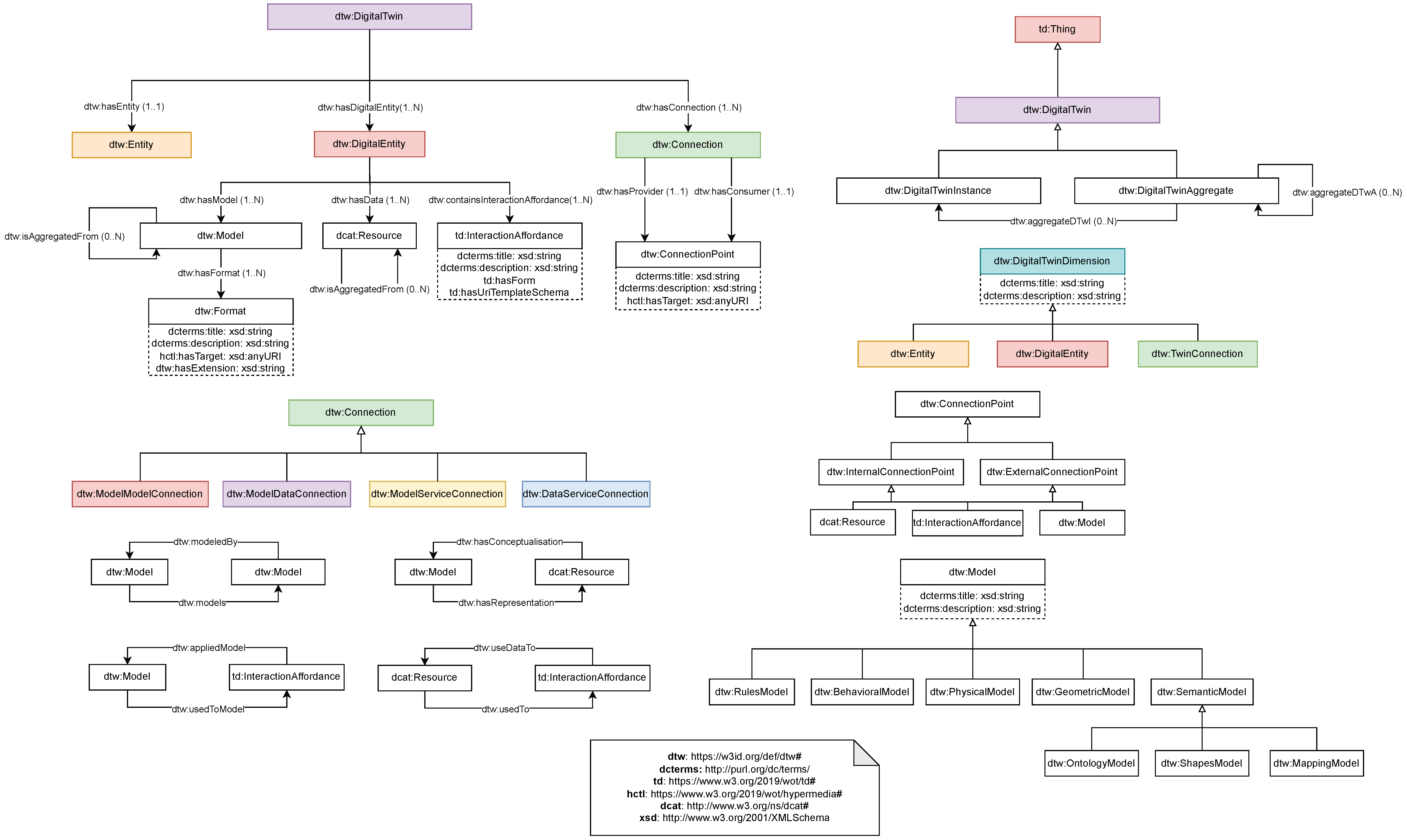


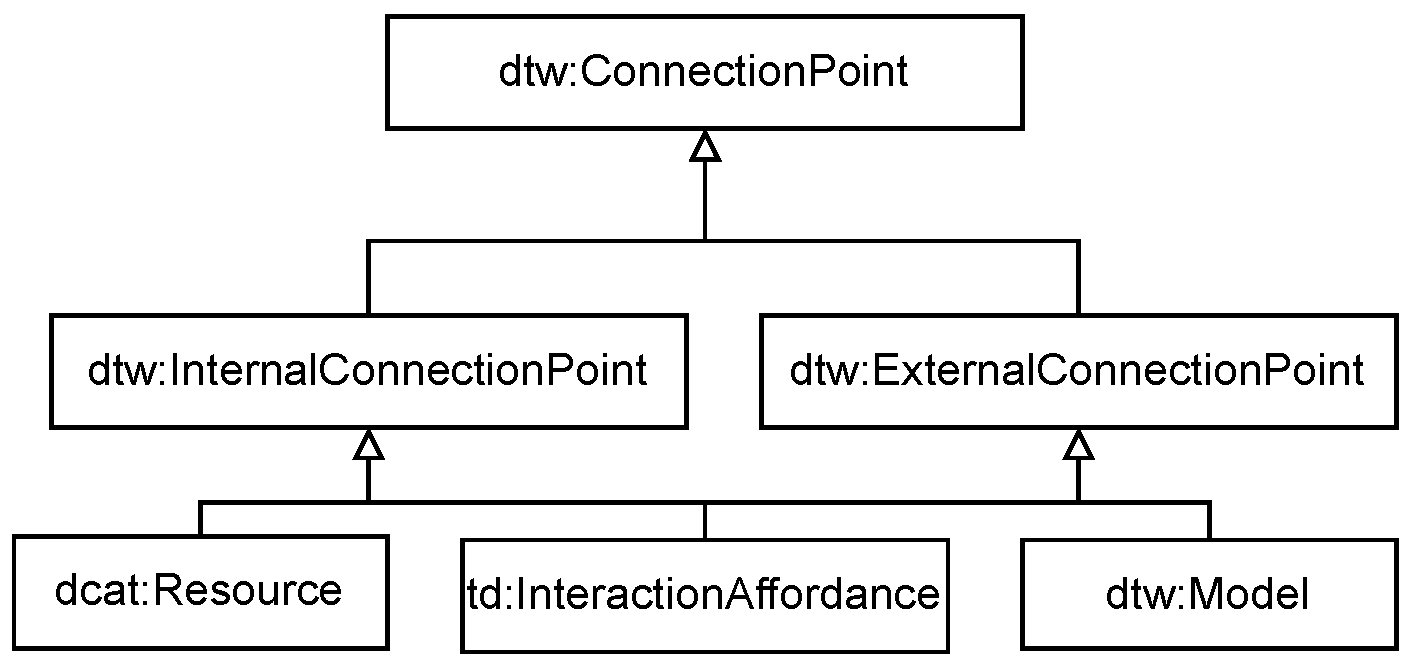
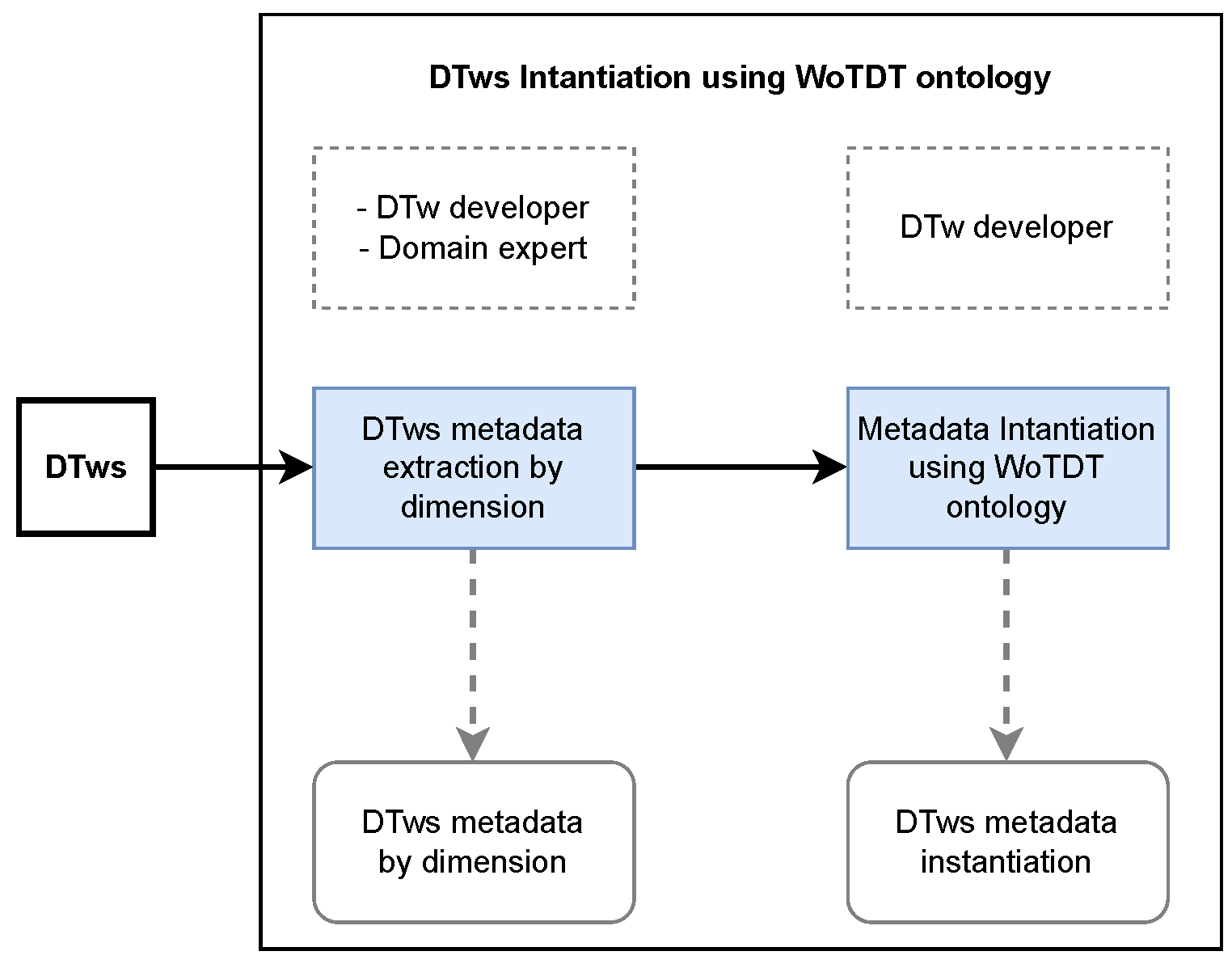
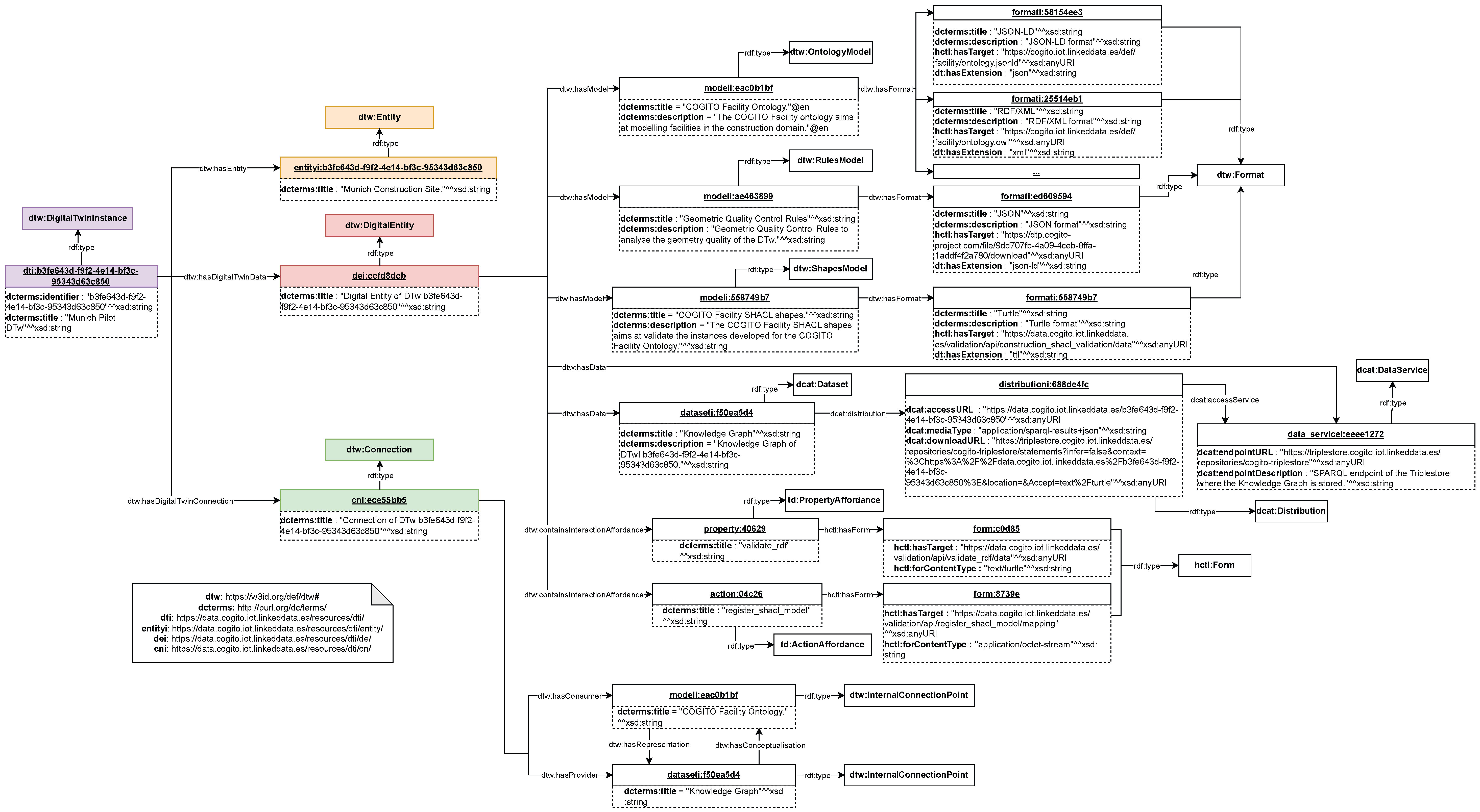
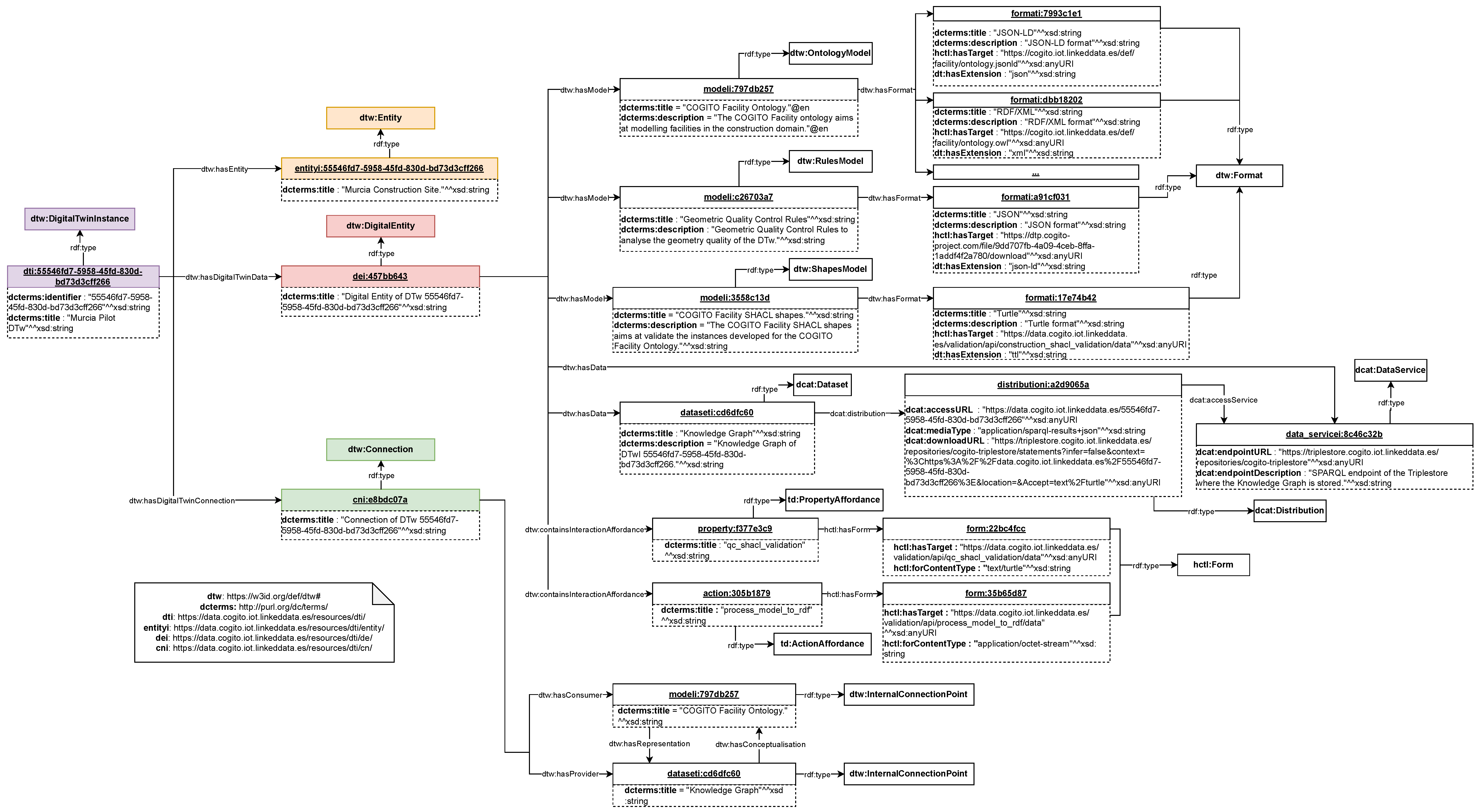
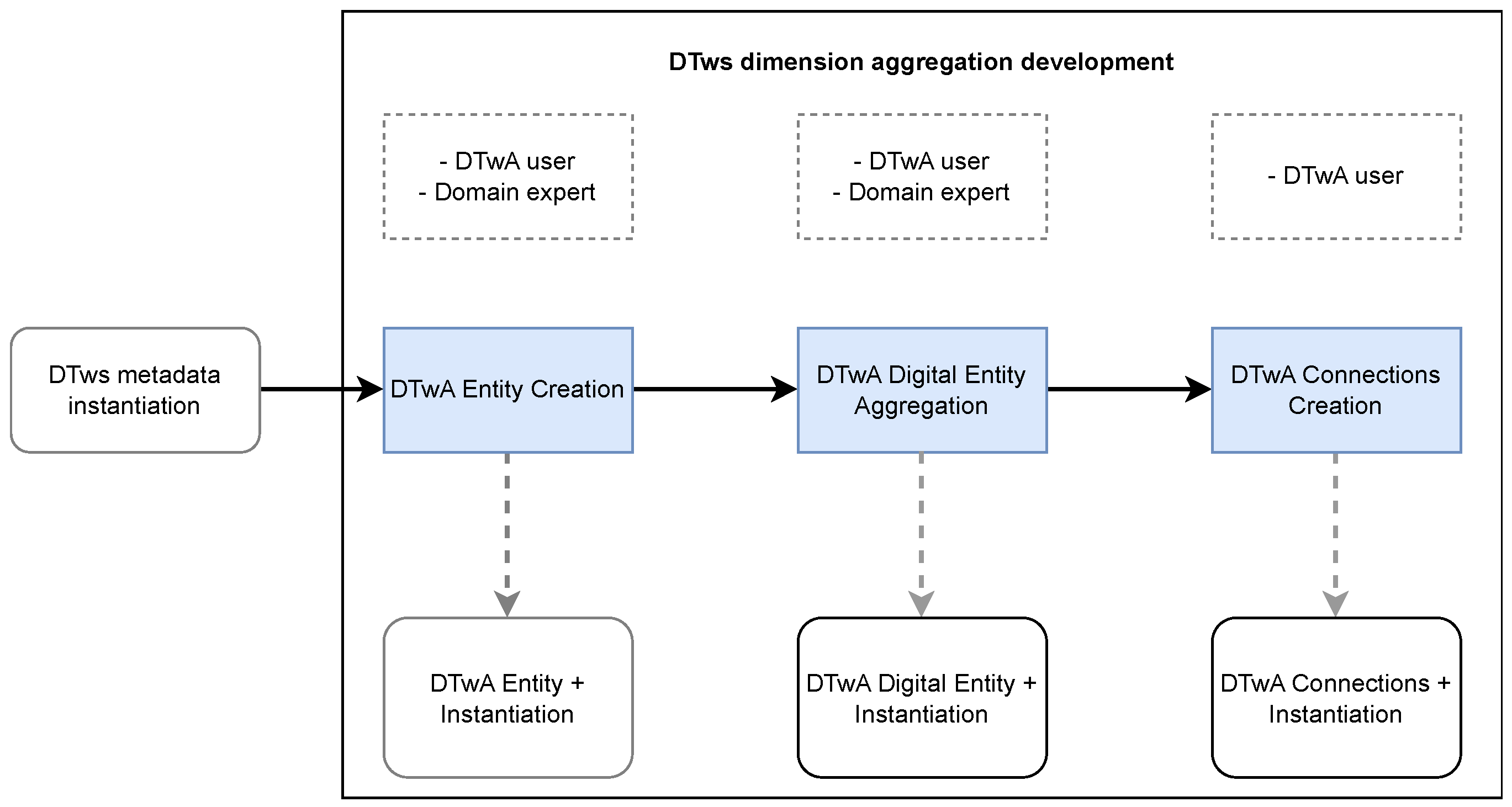

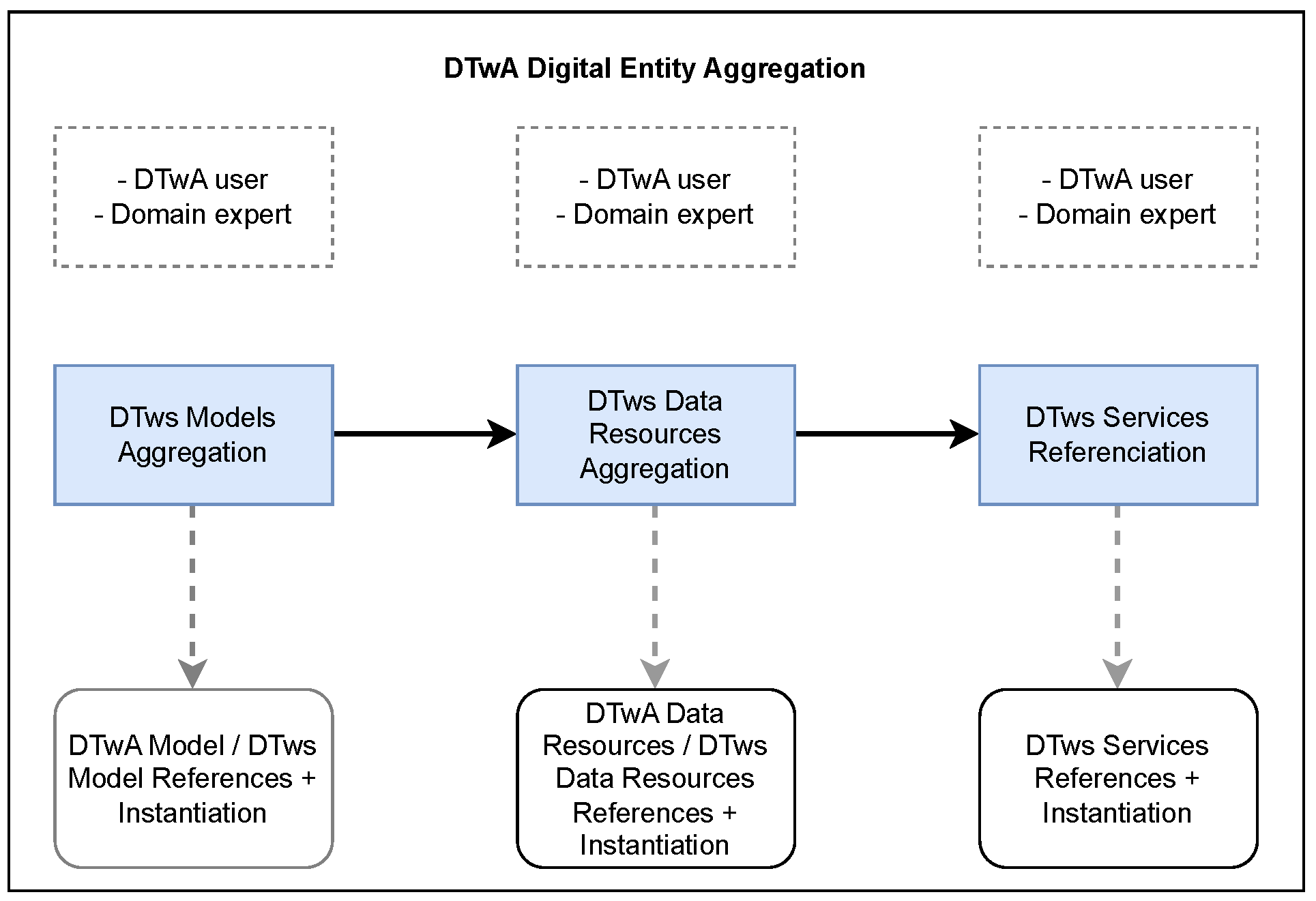



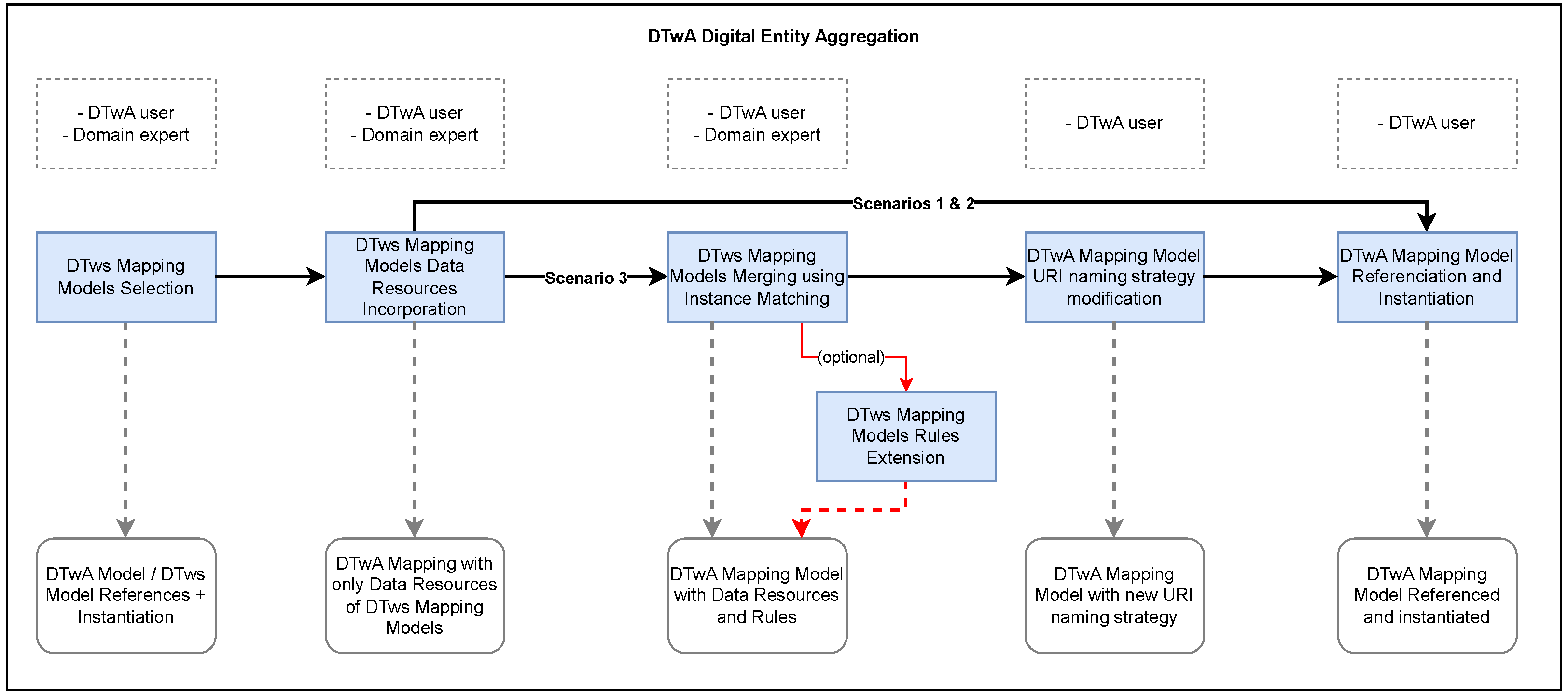








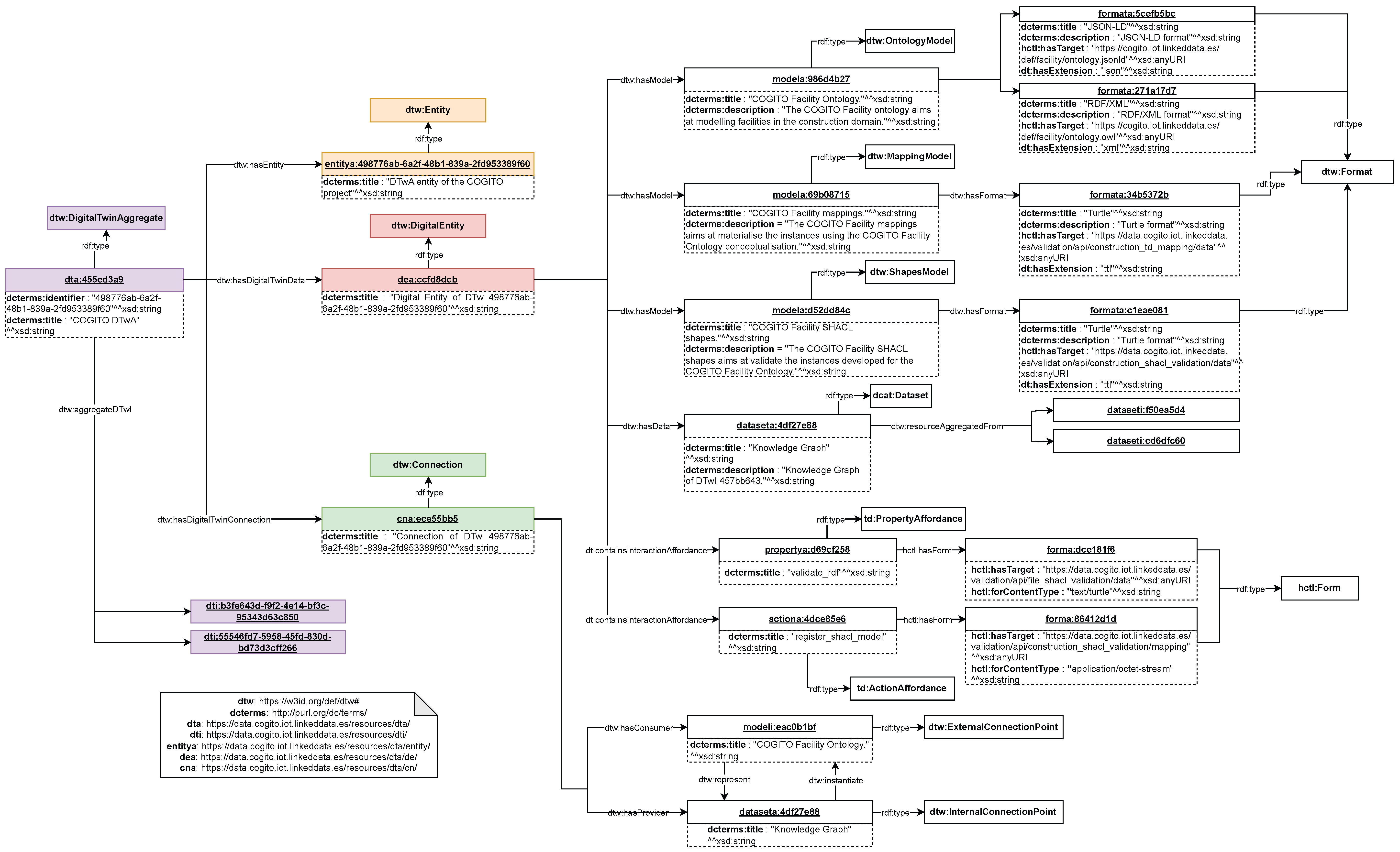
| ID | Competency Question/Statement—Possible Answer |
|---|---|
| WOTDT-1 | A digital twin is a thing. |
| WOTDT-2 | A digital twin contains five dimensions. |
| WOTDT-3 | Physical entity is a dimension that represents the real-world asset of the digital twin. |
| WOTDT-4 | Digital entity is a dimension that represents the digital asset of the digital twin. Also, it contains the dimensions of the virtual entity, DTw data, and DTw services. |
| WOTDT-5 | Virtual entity is a dimension that represents the different models used in the digital twin. |
| WOTDT-6 | DTw data is a dimension where are stored all the data used in the digital twin. |
| WOTDT-7 | Digital twin services is a dimension in which all services of the digital twin are described. |
| WOTDT-8 | DTw connection is a dimension in which all the connections between other dimensions in the DTw and with other external DTw dimensions are described. |
| WOTDT-9 | Virtual entity dimension can have models. |
| WOTDT-10 | Which kind of models can be described in the virtual entity dimension? The models can be from rules, behavioral, physical and geometric models to semantic models like ontologies. |
| WOTDT-11 | DTw data dimension can have resources that can be used to represent different types of data stored at the digital twin. |
| WOTDT-12 | DTw service dimension can have interaction affordances from the WoT thing descriptions ontology to represent the different services used at the digital twin. |
| WOTDT-13 | DTw connection dimension can have different connections. |
| WOTDT-14 | Which type of connections can the digital twin connection dimension describe? The connections defined in the DTw connection dimension are described with the different existing elements of other dimensions of the DTw, such as models, resources, and interaction affordances, and the connections with external things such as other DTws. |
| WOTDT-15 | Digital twin instance (DTwI) describes a specific corresponding physical product to which an individual DTw remains linked throughout the life of that physical product. |
| WOTDT-16 | Digital twin aggregate (DTwA) describes the aggregation of DTwI and DTwA. Unlike the DTwI, the DTwA may not be an independent data structure. It may be a computing construct that has access to all DTwIs and queries them either ad-hoc or proactively. |
| WOTDT-17 | Connections between DTws can be represented as external connection points. |
| WOTDT-18 | Aggregations between data models metadata or the data resources metadata of the DTws can be represented in the resulting DTwA within the connections between them. |
| DTw | Entity | Model | |||||||
|---|---|---|---|---|---|---|---|---|---|
| ID | Title | ID | Title | Type | ID | Title | Description | Format | Access URL |
| b3fe643d-f9f2-4e14-bf3c-95343d63c850 | Munich Pilot DTw | b3fe643d-f9f2-4e14-bf3c-95343d63c850 | Munich Construction Site | Ontology Model | eac0b1bf | COGITO Facility Ontology. | The COGITO Facility ontology aims at modelling facilities in the construction domain. | JSON-LD | https://cogito.iot.linkeddata.es/def/facility/ontology.jsonld, accessed on 18 May 2024 |
| RDF/XML | https://cogito.iot.linkeddata.es/def/facility/ontology.owl, accessed on 18 May 2024 | ||||||||
| N-Triples | https://cogito.iot.linkeddata.es/def/facility/ontology.nt, accessed on 18 May 2024 | ||||||||
| Turtle | https://cogito.iot.linkeddata.es/def/facility/ontology.ttl, accessed on 18 May 2024 | ||||||||
| Rules Model | ae463899 | Geometric Quality Control Rules. | Geometric Quality Control Rules to analyse the geometry quality of the DTw. | JSON | https://dtp.cogito-project.com/file/9b5fe1ab-fec2-471c-93f2-eab17040cb2b/download, accessed on 18 May 2024 | ||||
| … | … | … | … | … | … | ||||
| Services | Connections | ||||||||||
|---|---|---|---|---|---|---|---|---|---|---|---|
| Type | ID | Title | Description | Access URL | Content Type | Type | ID | Title | Description | Provider ID | Consumer ID |
| Property Affordance | 40629 | validate_rdf | Validate RDF Data | https://data.cogito.iot.linkeddata.es/validation/api/file_shacl_validation/data, accessed on 18 May 2024 | text/turtle | Model-Data Connection | ece55bb5 | Connection of DTw455ed3a9 | Connection between a model and a dataset | eac0b1bf | f50ea5d4 |
| Action Affordance | 04c26 | register_shacl_model | Register SHACL Shapes | https://data.cogito.iot.linkeddata.es/validation/api/construction_shacl_validation/mapping, accessed on 18 May 2024 | application/octet-stream | ||||||
| … | … | … | … | … | … | … | … | … | … | … | … |
Disclaimer/Publisher’s Note: The statements, opinions and data contained in all publications are solely those of the individual author(s) and contributor(s) and not of MDPI and/or the editor(s). MDPI and/or the editor(s) disclaim responsibility for any injury to people or property resulting from any ideas, methods, instructions or products referred to in the content. |
© 2024 by the authors. Licensee MDPI, Basel, Switzerland. This article is an open access article distributed under the terms and conditions of the Creative Commons Attribution (CC BY) license (https://creativecommons.org/licenses/by/4.0/).
Share and Cite
González-Gerpe, S.; Poveda-Villalón, M.; García-Castro, R. DTAG: A Methodology for Aggregating Digital Twins Using the WoTDT Ontology. Appl. Sci. 2024, 14, 5960. https://doi.org/10.3390/app14135960
González-Gerpe S, Poveda-Villalón M, García-Castro R. DTAG: A Methodology for Aggregating Digital Twins Using the WoTDT Ontology. Applied Sciences. 2024; 14(13):5960. https://doi.org/10.3390/app14135960
Chicago/Turabian StyleGonzález-Gerpe, Salvador, María Poveda-Villalón, and Raúl García-Castro. 2024. "DTAG: A Methodology for Aggregating Digital Twins Using the WoTDT Ontology" Applied Sciences 14, no. 13: 5960. https://doi.org/10.3390/app14135960
APA StyleGonzález-Gerpe, S., Poveda-Villalón, M., & García-Castro, R. (2024). DTAG: A Methodology for Aggregating Digital Twins Using the WoTDT Ontology. Applied Sciences, 14(13), 5960. https://doi.org/10.3390/app14135960







